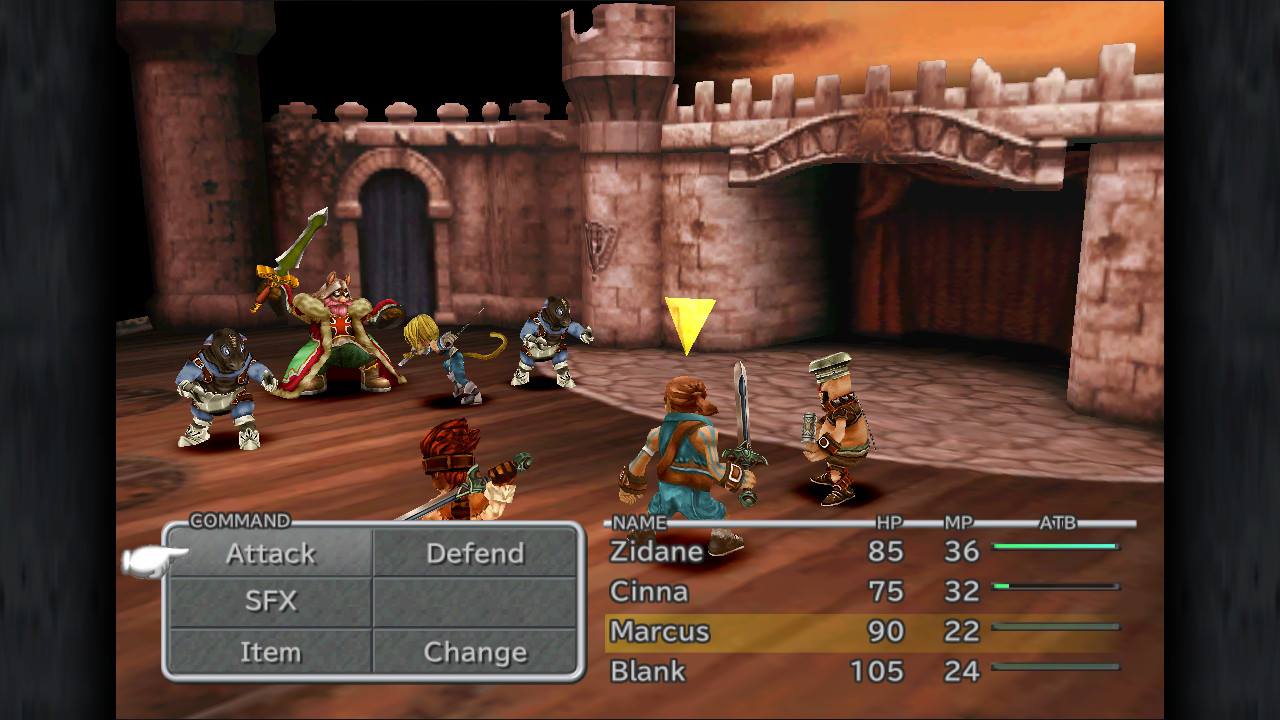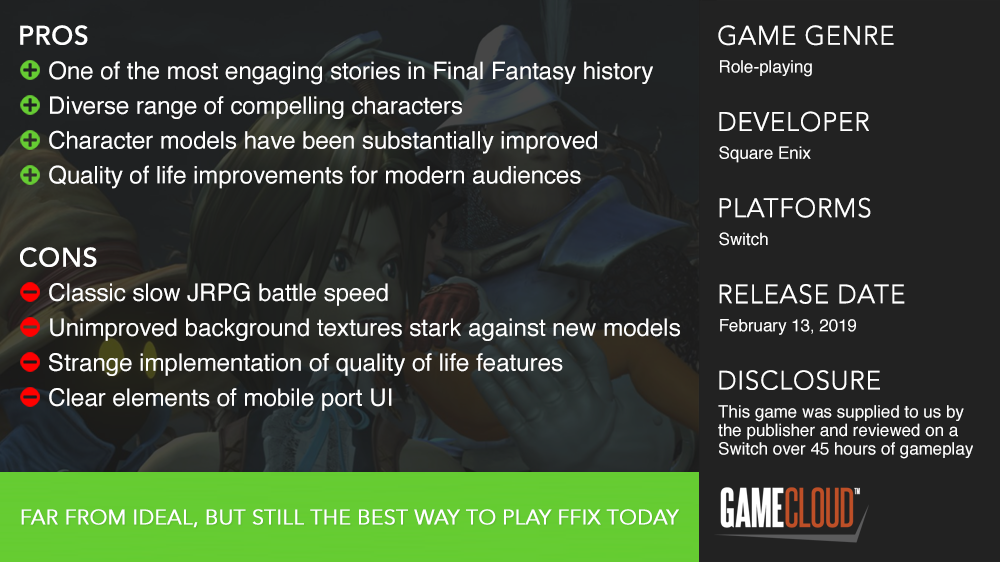
It’s hardly unique of me to say that Final Fantasy was the series to introduce me to the concept of turn-based RPGs at a young age, and the reason I’m so enthusiastic for the genre to this day. I find that all fans tend to have a favourite that they’ll defend to the death, but also seemingly always at least one that they “missed,” not playing until much later in life. Final Fantasy IX was the latter for me, only having played it once in my early adult life. With Square Enix releasing a Switch port, I was interested in taking on the challenge of viewing the classic from a modern perspective with as little nostalgia-induced bias as possible.
Before we dive into the specifics of the port, let’s discuss the game itself for those who may not be familiar. Final Fantasy IX takes place on the planet of Gaia, covered in a substance known as “Mist” which seems to be connected to the monsters that run rampant. The tale follows Zidane, a member of an airship-borne theatre troupe, and a plan to kidnap the princess of the city of Alexandria. To say much more than this would be to rob you of some stellar story-telling: each of the major arcs of the tale take you through many unexpected developments, both on a world-scale and for each of the cast of characters.

These characters are the crux of what makes this particular iteration of Final Fantasy so memorable. It’s not hard to see when lined up against any other game in the franchise, as the cast is eclectic in all areas: design, motivations, speech patterns, everything about them embodies the idea of a “motley crew.” While I may be a hardcore Final Fantasy VIII fanboy, I would be remiss not to acknowledge that Final Fantasy IX has arguably the best main party the studio has done to date.
It’s worth acknowledging that, while this is a well-written and engaging game in the series, it is nonetheless a Final Fantasy game at its core. The game uses both the ATB combat system and random encounters that the era is famous for, the former involving waiting for a bar to fill up before a character can take action. While these were the standard for the time, these models certainly feel outdated by modern standards, with the frequent battles becoming a significant annoyance. If you don’t care for the gameplay of the genre in general, you’ll find little to change your mind here.

Also a symptom of its time, you’ll find the issues of speed bleed into most aspects of the game. Cutscenes can move agonisingly slow, the camera sometimes panning across a vista so gradually you’d think your console was struggling. Movement through the world is hardly snappy, especially given the size and complexity of some zones. While a quick-fix solution has been applied to resolve this, which I’ll discuss later, it’s clear the port has taken the “authentic” approach to not altering the core experience from its ancient ways.
But naturally, the experience of a Final Fantasy game doesn’t come from its core battle system, which is rarely innovative or extremely unique. Along with its fantastic cast and engaging storyline, you’ll find an unforgettable soundtrack to drive you through the journey, a simple but effective skill system that I’d like to see used more today and some breath-taking sights even given the low resolution of the views. If you, like me, are an RPG fan who missed Final Fantasy IX as a child, I’d implore you to give this one a shot.

All that said, the implementation of the port itself is key to the modern experience. While a classic Final Fantasy game is hardly one I’d consider particularly suitable to the Switch, I tend to enjoy all games more just for the sake of having them be able to easily switch between the screen and handheld mode, and Final Fantasy IX is no exception. I had a couple crashes, but the game seems to auto-save extremely frequently, and I never lost more than a minute or two of progress.
The character models have been made to look better than I could ever have expected, giving new life to the denizens of Gaia. It’s clear that this wasn’t a simple case of “buffing the edges,” as a side-by-side will immediately show not only the high-quality of the new models but a slight redesign to make them look more believable as beings. However, as the backgrounds have not been improved in the slightest, these new models now look incongruous to the rest of the world, like they’ve been slapped up against a rough painting and told to act natural. It’s hard not to see, especially when close up, and it’s a shame the time wasn’t taken to try and improve all elements of this experience.

Some general quality of life improvements have been implemented that are much appreciated, even for a someone like me who’s not unfamiliar with the classical features of the genre. Much like the recent port of Final Fantasy XII, a “hyper speed” option has been included to help get you through the long fights and slow cutscenes, some so slow that even utilising this method I still found it to be sluggish. Some cheats have also been included for those not looking to be tested by the standards of a generation past, such as maximum damage or infinite money. It’s certainly a lazier solution than implementing an “easy mode” for the same purpose, but this is understandable given the development time such a feature would have required.
That said, these features have been included in strange ways. While the “hyper speed” mode can be directly compared to the one in Final Fantasy XII, it’s been done so much more poorly. Where Final Fantasy XII has a single-button toggle that easy to switch on the fly, here we have to pause the game to be able to toggle it. This one extra button press slows down and discourages the use of the feature and, since the pause menu also features other cheats on similar buttons such as the “maximum damage” buff, it’s easy to turn on another such feature without realising it. A direct copy of Final Fantasy XII’s system would have been just fine in my books.
Lastly, the interface is clearly pulled directly from the mobile port. While this isn’t inherently terrible, it’s a shortcut that cheapens what should be a significant experience. The combat UI is inherently unattractive, the buttons for combat crying out to be touch-controlled by their design, despite no such touch-control being included. Character naming screens take up notable space to warn me to not use emoticons, a warning I’m certainly not used to seeing on my home console.

There are a lot of ways this port of Final Fantasy IX could have been so much more than it is, from a simple change like a console-relevant UI to more challenging ones like the improvement to the background textures. While these gripes are justified in my opinion, the experience of the core game itself has not been affected: Final Fantasy IX is easily one of the best stories in the series with a cast on-par, if not stronger, than any recent game you care to name. While I feel it does little to win over modern gamers, fans of the genre who didn’t get to enjoy this one in their childhood would be doing themselves a disservice to not pick this one up immediately.











